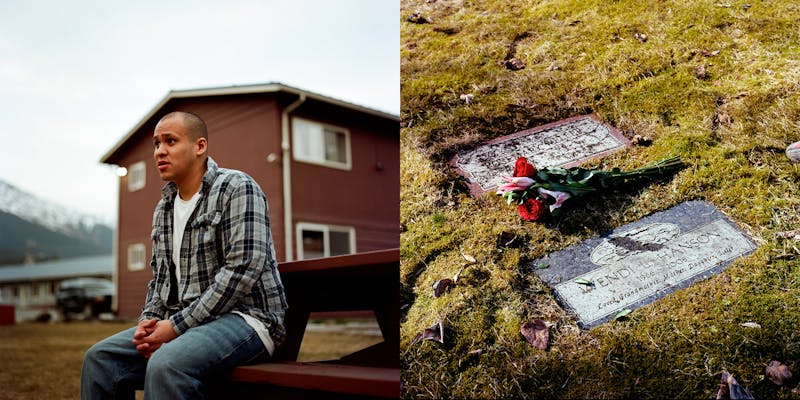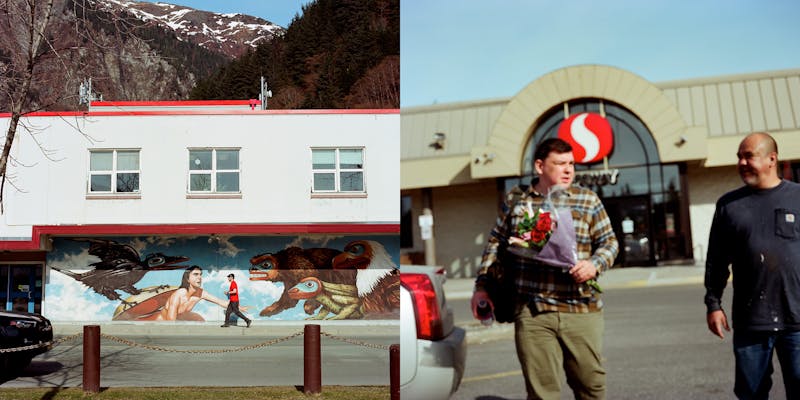My ancestors had no written language, so they told their
stories to the trees. Ten thousand years after the Tlingit people settled
Alaska’s southeastern archipelago, these islands remain stippled with monuments
to their myths: totem poles, carved from massive logs of cedar and adorned with
images of animals and spirits, rise up from the damp earth like great scrolls. When
I was young, my grandmother taught me how to read them.
The first lesson was this: Always start at the bottom, then
cast your eyes upward in search of the unfolding story. This became, for a
time, my preferred way of investigating the world around me. A boat was
measured first by its barnacles, and a person by their shoes. In Petersburg,
where I grew up, commercial fisherman like my uncles and my grandpa all wore
the same brown xtratuf boots. In the jail where my father lived, everyone except
the guards wore cheap slip-ons with thin soles. My grandmother, whose feet were
badly crippled by rheumatoid arthritis, could only wear sandals; surgeons had
made it possible for her to walk in her later years by inserting steel rods, as
thick as pencil leads, down the length of each toe, and they protruded like antennae,
glistening with antiseptic ointment. She kept the ointment in her medicine
cabinet, along with many other things that captured my imagination.
On the bottom shelf of the medicine cabinet, next to her denture cream, she kept in a small velvet pouch her glass eye, which replaced one that she’d lost when a schoolyard bully threw sand in her face. On the middle shelf were salves and ointments. And on the top shelf, far from my reach, sat a collection of translucent orange pill bottles, each stamped with her maiden name: ROSEMARY RUTH AXSON.
Pain management was central to my grandmother’s daily routine. While rubbing ointment on her swollen hands, she’d tell me about the nuns who would rap her tiny knuckles when they caught her speaking the Tlingit language in school; when her back ached, she’d swallow a painkiller and talk about her years hunched over a fish-gutting table at the town cannery; and when her head ached, she’d pour an Excedrin from its giant green bottle and sit with me in silence until it started working. She made from these moments of temporary relief a life worth living.
In the spring of 2003, I visited Alaska after a long time away, and found something new in her medicine cabinet. It was a painkiller called Oxycontin. Swallowing these opioids made her bright and cheerful, I noticed, then, as the hours passed, quiet and withdrawn. When the time for her next dose drew near, she grew irritable and anxious. These symptoms were familiar to me: As a child, my mother had for a time abused heroin; more recently, at the age of twenty-one, I spent a weekend in jail for passing bad checks at a supermarket in Seattle, and had shared a cell with a heroin user who passed the nights vomiting and sweating through his sheets. My grandmother experienced something only a bit less severe when she exhausted her supply of Oxycontin before her prescription could be refilled.
The first time she ran out of pills early, I assumed she’d lost track and taken a few pills ahead of schedule. My aunt Wendi, who worked as her live-in caretaker, promised to keep a closer eye on things. But it kept happening. By the time I left Alaska that summer, I was sure that my grandmother was taking more than her prescribed dose of Oxycontin—the only question in my mind was whether she was doing it because of a rising tolerance or a blossoming addiction.

In January 1975, Congress passed the Indian Self-Determination Act, meant to help tribes throughout the nation become more self-sufficient. In Alaska, the most visible legacy of this legislation are the community health clinics that serve the state’s indigenous population. Clinics in 28 of these communities are managed by the Southeast Alaska Regional Health Consortium, or SEARHC.
For much of my childhood, these non-profit clinics were all I knew of health care. Their dentists filled my cavity-ridden teeth, their doctors treated my chicken pox, and, when I was eight, their emergency staff cleaned and stitched a quarter-sized hole in my right arm, where my little brother stabbed me with a jagged piece of aluminum from a broken picture frame. My grandmother relied on their care even more, not only for her arthritis, but also during long periods of recovery following a stroke and an aneurysm. She trusted SEARHC doctors with her life, and for decades they proved that trust to be earned.
Then the Food and Drug Administration made a decision that changed her life, and the lives of millions of other chronic-pain sufferers.
When Oxycontin was first approved for sale in the U.S. in 1995, regulators designated it as a safe and effective treatment only for managing short-term pain. Six years later, under pressure from drug makers like Purdue Pharma, the FDA sanctioned its long-term use, despite an absence of new research showing that more extended usage of the drug would be safe. Under these looser FDA regulations, Purdue Pharma stepped up its campaign “to conceal or minimize the risks of—and to circumvent or ignore safeguards against—opioid abuse,” according to a lawsuit filed last year by SEARHC. “Instead of acting with reasonable care and in compliance with their legal duties,” the lawsuit alleged, Purdue Pharma and other drug makers had “intentionally flooded the market with opioids and pocketed billions of dollars in the process.” Sales of Oxycontin, which had been a robust $44 million in 1996, jumped to more than $1 billion annually after the FDA’s 2001 decision. By 2004 it was one of America’s most abused drugs.
Dr. David J. Vastola, who serves as the medical director for SEARHC, told me in April that Alaskans proved to be particularly vulnerable to the opioid crisis that took root following the FDA’s 2001 decision. “A large number of Alaskans are fishermen or loggers, who beat up their body and end up with the kind of chronic pain that led them to seek prescriptions for Oxycontin,” he told me.
Commercial fishermen are considered so vulnerable, in fact, that in August 2017 Walt Monegan, then Alaska’s commissioner of public safety, sent a letter to the owner of every commercial fishing vessel in the state. “All Alaskans,” he declared, “have the right to work and live in safe and healthy environments, and it is time to reverse the destructive impact opioid abuse has had on our state, so I am reaching out to you to ask that you do your part to ensure that Alaska’s fishing crews are safe from the impact of opioid abuse.”
Alaska Natives are also considered a particularly at-risk population for opioid addiction because we experience high rates of rheumatological conditions like arthritis. This is supported by unambiguous statistical data: Between 1999 and 2015, deaths by drug overdose rose more than 500 percent among rural Alaska Natives and American Indians—the largest percentage change among any racial or ethnic group in America. And in 2015, as the prescribing of opioids reached its peak in states like Alaska, no other group of Americans experienced a higher rate of death by drug overdose. Still, few seemed to notice, beyond the keepers of such statistics at institutions like the Centers for Disease Control and Prevention and the Indian Health Service. I was among those who had been blind to the misery of my own people.
My grandmother died in 2007, before I worked up the courage to ask her any tough questions about her Oxycontin use. A short while after her death, I tossed aside my lingering suspicions that she’d been hooked on the drug; the issue of my grandmother’s missing pills seemed less mysterious after a cousin who had lived with her was arrested with Oxycontin in his possession. This question, and others, were revived, however, by the lawsuit SEARHC filed against Purdue Pharma—a lawsuit in which SEARHC effectively admitted that it had served as an unwitting instrument in Purdue’s crusade to hook vast numbers of Americans on opioids, spreading addiction and misery in the communities where I grew up. So, in April, I went home to Alaska for the first time in nine years, to ask my cousin the tough questions I’d failed to ask my grandmother.

I found Keith living in a halfway house in Juneau, at the foot of Thunder Mountain, which was named for the sounds that echo through the Mendenhall Valley when avalanches send rocks crashing down its slopes during the spring thaw. I’d last seen my younger cousin during the spring of 2003, when he was twelve years old. The intervening years had been hard on him: In 2008, he woke one morning to find that his mother, my aunt Wendi, had died in her sleep. She was 42. Her heart failure had been brought on, I was told, by taking opioid pills that had not been prescribed to her. Keith, too, began swallowing his depression with mouthfuls of other people’s pills.
Oxycontin was a favorite, and it was easy enough to find in
Southeast Alaska. Purdue Pharma had focused its marketing efforts there on
primary care doctors, who were, SEARHC claimed in its lawsuit, “more likely to
treat chronic pain patients and prescribe them drugs” and “less likely to be
schooled in treating pain and the risks and benefits of opioids and therefore
more likely to accept” Purdue’s “misrepresentations.” (Purdue did not return requests for comment.) Doctors
at SEARHC clinics increasingly prescribed Oxycontin for long-term use, while
the agency also helped some Alaska Natives get cheaper access to the drug. That
made opioids so easy and cheap to acquire that some sought prescriptions just
so they could sell the pills. Keith’s dealer was his classmate’s mother, who
sold him 5 mg Oxycontin pills for $5 each.
Years later, when doctors began prescribing the drug more warily, prices skyrocketed, and Keith, like so many others, turned instead to heroin. To pay for the heroin, he turned to petty crime, which led to some 20 arrests, the most recent of which had landed him in the halfway house where, as a journalist, I asked him things I’d never had the decency to ask him as his cousin.
I found him at the reception desk, standing beneath a sign that underlined the strictness of the halfway house’s mandatory drug and alcohol testing: “DO NOT DRINK KOMBUCHA TEA,” it read. “YOU WILL POP HOT FOR ALCOHOL.”
Incarceration had agreed with him. He told me he had not used heroin since September 2017, and his face, once pale, gaunt, and hollow, was again full of shape and color. He wore his fitness loosely, like an actor who might be asked at any time to shed it for some new role. Outside, we talked across a picnic table, where I teased him for stealing a car in a small island town where there were few roads and he was bound to be caught. But the car, like the drugs, was never really meant to take him anywhere.
It was difficult asking my cousin to describe his darkest moments and his greatest failures, especially when he was working so hard to move past those bad times. As the end of visiting hours approached, I turned to the uncomfortable subject of how he’d first got his hands on Oxycontin.
The answer, I feared, was that his addiction began after he stole pills from my grandmother. But Keith swore he hadn’t taken any of her Oxycontin. And with this mystery unsolved, he told me something that would lead to even darker questions: “I’m pretty sure she was selling them and giving them to mom and auntie,” he said.
My mother and my aunt Wendi had been addicts since their teens, and had acquired drugs all sorts of ways—buying prescription pills from a relative was hardly surprising behavior for them. What was surprising, and upsetting, was the realization that my grandmother might have given her daughter the very drug that would end her life.

On February 14, 2017, Alaska Governor Bill Walker declared opioid use a statewide “public health disaster emergency.” In the years leading up to this declaration, SEARHC had taken steps toward reducing opioid dependence in the communities it served. The most important of those steps was to require its physicians to seek committee approval before writing new prescriptions for powerful opioids like Oxycontin. This practice, which is, in essence, a rebuke of the FDA’s 2001 guidelines for prescribing Oxycontin, has done something powerful—SEARHC physicians, following this protocol, are no longer instruments of opioid makers, and instead serve only the interests of their patients. What this important change has failed to do is erase the lingering hunger for opioids.
“Many patients are frustrated when we refuse to write them a prescription for opioids,” Vastola said. “They’ve been led to believe that these drugs are what they need, and they get upset, and often quite defensive, when they are told otherwise.”
Such people, it seems, often end up acquiring opioids by other means. Two years ago, burglars in Haines, a small Southeast Alaskan community that sits near the Canadian border, stole an unspecified quantity of Fentanyl from a SEARHC clinic. Later that same year, agents from the Department of Homeland Security intercepted 15,000 doses of illicit Tramadol that had been shipped to Alaska from Singapore. In Juneau, police have seen a rise in certain types of crime that they associate with opioid abuse.
“We saw a steady increase in opioid abuse in the years leading up to 2015, and in the years since then we’ve seen a huge increase,” said Erann Kalwara, a spokesperson for the Juneau Police Department. “A lot of people who used to be recreational drug users are now addicts.”
There are other, less obvious consequences of the unbridled avarice displayed by the Sackler family, owners of Purdue Pharma. One of them, according to Vastola, is the loss of trust in community physicians. “It will take years to rebuild the good relationships that have been destroyed by the greed of these pharmaceutical companies,” he said.
Clinics run by SEARHC also face a prolonged financial struggle. Opioid makers effectively defrauded the nonprofit organization, its lawsuit alleged, by convincing its doctors to over-prescribe medicines that would then be subsidized by its consortium of nonprofit clinics. Furthermore, in spurring an epidemic of opioid addiction, these drug manufacturers have also forced SEARHC to subsidize the cost of treatment for Alaska Natives who had no problems with drugs prior to using opioids for the management of chronic pain.
Purdue Pharma may have avoided its reckoning with health care providers like SEARHC. By declaring bankruptcy earlier this week, the company will effectively nullify many of the lawsuits filed against it by SEARHC and similar organizations, proposing the establishment of a trust that would distribute payouts to plaintiffs.
On my last day in town, I went to the grocery store with my mom. We took the bus, which stopped along the way near the halfway house, where my cousin Keith stepped aboard. He was heading to a job interview, he told us—it was the only thing that got him back out in the world, where he could shake for a few hours the sense of being a piece of inventory on a shelf.
My mom hadn’t seen Keith in a while, and told him he was looking healthy. He told her the same thing, and for a few minutes they talked about other people’s problems. Once these adjacent miseries were exhausted, they talked about their own struggles, while I sat quietly with a familiar kind of shame. As a child, I dreaded these chance encounters on the bus, because they so often led my mom to talk openly, even loudly, about our most embarrassing problems—poverty and prison sentences and alcoholism, things so disgraceful to me that I constructed elaborate lies to keep my friends from learning about them. Back then, I was ashamed of the indignities we suffered; now, I realized, I was ashamed that I could not accept the reality of my situation with as much dignity as my mom and my cousin.
I was also troubled by something else—some ineffable sense that I, too, should be locked away in that halfway house. But unlike Keith, my mother had survived long enough to push me onto the shores of adulthood, where I eventually found my way. In the months that followed, I would travel to China, Korea, Japan, and Indonesia, while Keith would end up back in prison after failing a random drug test.
Eventually, Keith got off the bus, and my mom and I were alone. We passed the time talking about how much I’d loved libraries as a kid, and I told her how strange it was to think about that now that I’d published a book of my own. She always knew that I could become whatever I wanted, she said, and I told her I was amazed I’d amounted to anything at all. After a while, the stories that came to mind were all sad ones, so we sat in silence. Once or twice I thought of asking her about grandma’s pills. But I didn’t.
